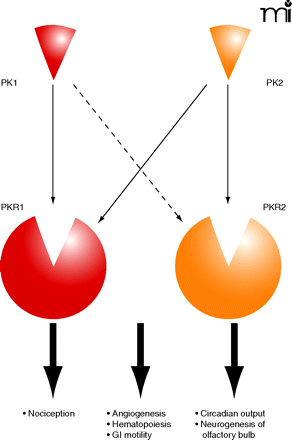
- Institution: Stanford Univ Med Ctr Lane Med Lib/Periodical Dept/Rm L109
- Sign In as Member / Individual
The Prokineticins: A NOVEL PAIR OF REGULATORY PEPTIDES

Biological functions of prokineticins. Prokineticins (PK1 and PK2) are a pair of cysteine-rich secreted molecules that exert their functions via activation of two G protein–coupled receptors (PKR1 and PKR2). Prokineticins are versatile molecules that regulate multiple biological processes, with apparent selectivity of ligand/receptor pairing. In particular, PK2/PKR2 signaling is critical for circadian clock output and neurogenesis of the olfactory bulb (OB), whereas the PK2/PKR1 pair plays a dominant role in pain perception. Prokineticins also regulate other processes, including gastrointestinal smooth muscle motility, angiogenesis, and hematopoiesis, where the involvement of ligand/receptor pairing is largely unexplored. The dashed arrow implies that PK1 and PKR2 may form a complex in unidentified functions.


